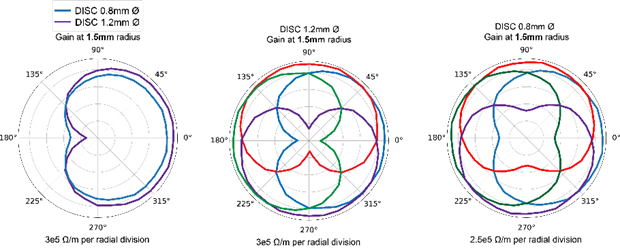Description:
UTHealth researchers developed a directional and scalable (DISC) electrode array, which achieved directional (stereo) measurements of local field potentials, resulting in up to 3x better signal amplitude, 1.6x higher signal-to-noise (SNR), and 98% decoding accuracy than the average testing results of a tetrode in over 450 stimulation recordings. This enables less noisy and more precise detection and localization of seizure or other brain activity, enhancing potential capability in epilepsy models and advanced decoding tasks.
Components:
The array design proposed here is an improvement on the state-of-the-art electroencephalogram (sEEG) by enabling the recording of spatially distinct local field potentials (LFP). This is achieved by radially positioning of electrodes around the array using advanced manufacturing techniques. The device demonstrates superior performance in terms of signal-to-noise (SNR), directional sensitivity, and decoding accuracy compared to a ring electrode, and additionally provides clinicians with equivalent fidelity as the macroscale ring electrode by averaging a concentric set of electrodes. As another demonstration of its powerful and diverse montaging capability, linear arrays of electrodes on DISC have also demonstrated spatially distinct current source density analysis.
Significance and Impact:
The tool developed in this invention is capable of high quality, multidirectional current source density (CSD) with mesoscale source separation and ring-equivalent recordings. The more generalizable design developed and prototyped here establishes the ability of microelectrodes fabricated on large substrates. DISC shows improved spatial diversity without the necessity of a large craniotomy as required in other devices such as ECoG arrays or microelectrode arrays such as the “Utah array”. Directionality and vertical span further improve decoding capability generating a greater diversity of signals that can be source separated and source localized.
Benefits/Technology Advantages:
- In vivo data in anesthetized rats and whiskers demonstrated that the LFP signals recorded by DISC are ~3x higher in mean amplitude and ~1.6x higher in SNR compared to tetrode readings. These metrics are respectively ~2x higher and ~1.3x higher for virtual 0.4-mm ring.
- DISC yields 98% decoding accuracy compared to tetrode (70.9%) and virtual 0.4mm macro (86.9%).
- Interchangeability with stereo-EEG depth arrays to achieve state-of-the-art placement accuracy, efficacy, and safety for detection of focal seizure type ailments.
- Offering greater scalability and directionality advantages over other devices such as linear microelectrodes.
- Recordings with microscale, mesoscale, and macroscale resolutions simultaneously.
Potential Applications: Application areas such as epilepsy diagnosis and advanced decoding of brain signals, e.g., brain computer interfaces, could benefit significantly from this invention. It can provide better understanding of LFPs in complex networks by providing unique montaging abilities between one or more devices. The resulting network maps will identify disease biomarkers and high fidelity decoding of brain activity.

Inventors
John P. Seymour
Nitin Tandon
Intellectual Property Status
Relevant Publications
- “Sensing Local Field Potentials with a Directional and Scalable Depth Array: the DISC electrode array”; doi: 10.1101/2021.09.20.460996
Stage of Development
Prototype
UTHealth Ref. No.: 2020-0018 WEB
Download summary